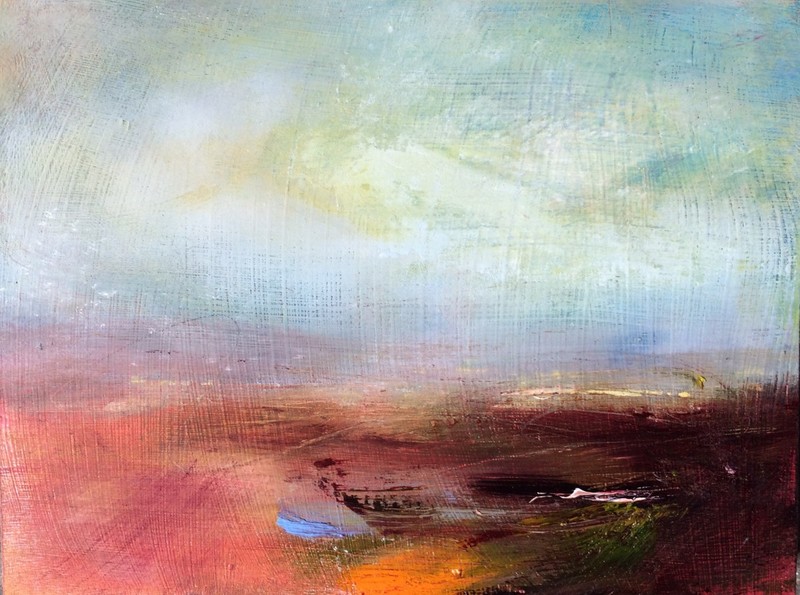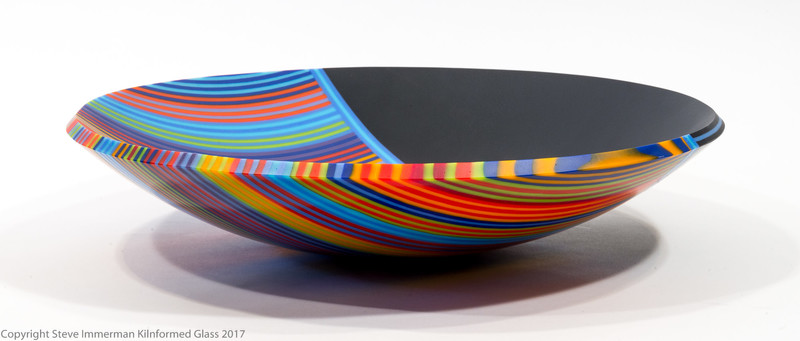 Anna Dean in her studio at The McColl Center. In this photo, she is seen working on an art project for Atrium Health about the impact of Covid-19.
Anna Dean in her studio at The McColl Center. In this photo, she is seen working on an art project for Atrium Health about the impact of Covid-19.
We asked artists around the world: “What is your role as an artist in society, your local community, and the world at large?”
Every artist plays a different and necessary part in contributing to the overall health, development, and well-being of our society.
Creative thinkers and makers provide their communities with joy, interaction, and inspiration, but they also give thoughtful critique to our political, economic, and social systems — pushing communities to engage thoughtfully and make steps toward social progress.
From documenting human history to expressing collective emotions, these nine artists from around the world tell us how they view their role as creative contributors.
 On the Quiet Moor by Lesley Birch
On the Quiet Moor by Lesley Birch
Artists are a vehicle for expressing universal emotion.
Art is about connecting with people’s emotions. It’s personal and at the same time, universal.
I’m an expressive painter, working from the landscape and my memories. And yes, my work is personal, although it may not seem so at first. Feelings about my relationship with my mum, dad, and family creep into the work.
It’s a human urge to express emotion through the medium of mark-making. We all carry with us memories of our past experiences.
An artist has the ability to ‘feel strongly’ to be ‘sensitive’ to things and express this in the paint, gesture, or color. The artist ‘absorbs’ the atmosphere of a place or the memory of a feeling. Sometimes, it’s a burden for the artist to carry all this emotion – to be so sensitive.
Most folks block out emotion. Then, suddenly, a painting ‘speaks’ to them. At that point, the artist has done their job. For me, it is wonderful to connect with people through my work — when people respond to a painting and really ‘feel’.
My painting is mainly about my self-expression communicated out there on the canvas, but really I think it is everyone’s expression — I’m just a vehicle.
Everybody hurts. Everybody loves. Everybody hopes. And, everybody dies. Mainly, art is about our own sense of mortality.
Lesley Birch, York, UK
@Lesley_Birch
 Wind by Nina Fraser
Wind by Nina Fraser
Artists are responsible for unearthing the truth.
I believe that the artist's role, above all things, is to be as true to themselves as they can — within society, the community, and the world at large. This sounds like a cliche but is in itself much harder than it seems.
Being an artist involves wearing all sorts of masks, just like any other job, but the difference is we have the lingering responsibility to unearth the truth of things. Sometimes we will seem vulnerable, sometimes we will make mistakes. But the main thing is not to give up.
This resonates with people on a personal and global level, because it is not only empowering but starts from inside ourselves. Before deciding to follow my own artistic path, I co-founded a community arts cafe. This was an amazing experience in itself, but as it wasn't my true vocation I felt there was a limit to how much I could give. This is because I started from the outside in, trying to fix things around me, before realizing I needed to tap into something central to myself.
Nina Fraser, Portugal
@Nina.fraser, @_ninafraser_

Kiss my... by Ginny Sikes
Artists work to illuminate the margins and make societal changes.
Rather than the word "role," I prefer "commitment." Over many years as an arts educator, I have helped people and communities find their voices and express their concerns through individual and collaborative art projects. This used to be called public art. Now, it is often known as social practice.
My own work is rooted in feminism – where expressing my emotions, goals, and ideas, in the realm of the personal, social and political, is an exercise in communicating my individual experience. Working with artists and in art spaces in other parts of the world, beautiful exchanges of ideas often happen –which creates artistic growth, empathy, and new understandings.
All of these acts can illuminate what lies hidden or repressed in the margins or shadows. New ideas can be brought to life. These ideas can lead to small or large changes in attitudes and even society.
Ginny Sykes, Chicago, USA

De Negen Bargen, Noordsche Veld, Zeijen by Maarten Westmaas
They tell stories and pass on traditions
Holland is a crowded space. Our history is filled with stories about how we made land out of the water and tamed the deadly seas. Honored by writers, poets, and painters. The word ‘landscape’ stems from the Dutch word ‘landschap’: View of the land. It was invented here in the 17th century, with low horizons and great cloudy skies.
Millions of landscapes were painted here by the great masters as Rembrandt, Ruysdael, Hobbema, Weissenbruch, Mauve, van Gogh and Mondriaan. All were inspired by our flat landscape and big horizons. It is this centuries-long tradition in which I stand. ‘Creating the Dutch landscape’ is my motto, my theme, and my life.
But, our landscape is changing. Our ever-growing population is altering the look of the land. Cities grow and our landscape history is sinking beneath concrete, buildings, and tarmac.
So, as an artist, I not only want the world to see the beauty of the Dutch landscape, but I also want to grow awareness about the lasting visible traces in the landscape. From our 5000-year-old megalithic monuments to our recent day modern windmills. As a photographic detective, I search for stories about our landscape.
We have to be careful with this landscape which is difficult with so little space and more than 17 million inhabitants. That's why I decided to donate 10 percent of all my income to the organizations that protect the Dutch landscape. That's the least I can do as an artist — to protect the horizon.
Maarten Westmaas, the Netherlands
@Maarten_Westmaas , @maarten.westmaas.dutch.landscape

Peace by Shih Yun Yeo
Artists connect with and inspire people globally
As we live in a global village, we are somehow all connected via some form of social media. Artists are no longer hermits and we are all "out there [in the world]". I hope my role as an artist is to inspire, connect, and collaborate!
My abstract works are paintings and drawings at the same time. Paintings of geometric and organic shapes and lines, composed of layers of ink, acrylic, and other mediums allude to the gestural surface marks of Abstract Expressionism. My paintings reflect not only with the radical conflict between the two "colorless" colors (black and white), but also their interaction and interdependence. There is a historical richness here, the temporal quality of landscape ink painting, the physical strength and boldness of the black ink, and its generosity and infinite possibilities.
Shih Yun Yeo, Singapore
 Untitled #15 by Bruno Castro Santos, 2017, color pencil and graphite on paper, 33x46cm
Untitled #15 by Bruno Castro Santos, 2017, color pencil and graphite on paper, 33x46cm
Artists record and preserve our human history
We live in an ever more intricate society where every individual regardless of its specific role plays an important part in the social biodiversity of the world.
Artists have been crucial from the very beginning of our existence. From prehistoric cave paintings to frescos around the world, to scientific drawings, to the avant-garde movements, artists have contributed to expanding human evolution from many different perspectives.
This expansion, much like the universe, is still going on and artists still play an important role. I see myself as part of a community whose work as a global force contributes to this human growth.
There is a crescent complexity in the way the art world evolves and the myriad agents who orbit around it are intimately interlaced with artists and their production. Although artists typically work alone in their studios, they are part of a much larger community and they play a much larger role than one might anticipate.
Bruno Castro Santos, Lisbon, Portugal
@Bruno.castro.santos
 INDUSTRIAL & URBEX: 'WHITSTABLE WHARF' (UK) by Aleta Michaletos
INDUSTRIAL & URBEX: 'WHITSTABLE WHARF' (UK) by Aleta Michaletos
Artists offer messages of hope
I take my role as an artist very seriously, although I still have endless amounts of fun and experience great joy in my studio. I try to be very thoughtful and socially and politically aware of my surroundings. Whenever I experience feelings of discomfort in my life, I need to find an answer by transforming those feelings through my art.
An artist's role is almost that of an Alchemist — capable of transforming a few humble materials into objects which are imbued with spiritual and aesthetic value and then possibly also material value.
I prefer to be a harbinger of good news and hope, in this increasingly broken world of ours and I find that images have immense power to restore collective emotional pain and lift the spirit.
Because I transform my own anguish concerning the present and also the future into something tangible which is simple, hopeful and beautiful, my role is to offer through my art and without being superficial, a message of hope to society, my community and the world at large.
Aleta Michaletos, South Africa
 Parrsboro Weir by Poppy Balser
Parrsboro Weir by Poppy Balser
They are ambassadors of the natural world.
I have always lived within walking distance of the ocean. I feel my role as an artist is to be an ambassador for the natural beauty that is found here. I paint out-of-doors as often as I can to get the clearest vision I can of my surroundings. That helps me capture it the most the highest level of truth.
I make my paintings to capture the parts of our landscape that I cherish and find beautiful. In doing so, I am preserving views that may disappear without notice. Think of all the paintings made of the Northwest landscapes that are now records of what those environments looked like there before the wildfires that have swept so much of that part of the continent.
One of my recurring subjects is the herring weir, which is made of nets to catch wild herring. The weirs are largely unique to the Bay of Fundy. When I was young there were herring weirs everywhere; they were commonplace. Now, they are almost all gone. I now have to travel a fair distance to paint the remaining ones while they are still here. These rather odd assemblages of netting might not mean much to people who have no connection to this area, but they are instantly recognizable to the people from here, who find great meaning in my paintings of the weirs.
I go out to paint the things that I find beautiful, never knowing what might someday become extra special because it, too, may no longer be easily seen outside of paintings. I put my paintings out into the world so that people who will never get a chance to come here might still be moved by the views of this place.
Poppy Balser, Canada
@poppybalser, @poppybalserpaintings

Polychrome by Steve Immerman
Artists create a sense of community.
There are many roles that an artist fills. But, in smaller cities, having local artists brings a sense of pride to the community. It also sets examples for young people who might be considering careers in the arts. Artists support their communities by teaching their art and craft.
Also, in most communities, there are auctions that benefit local causes and charities, and donations of art by local artists are some of the most popular items at these auctions.
Steve Immerman, United States
@docimmer, @clearwaterglass





